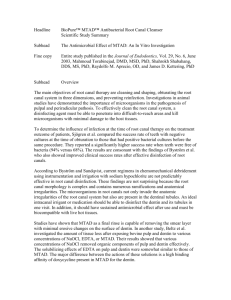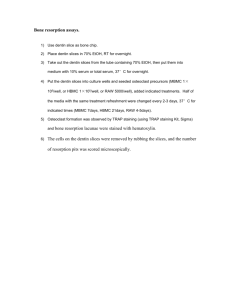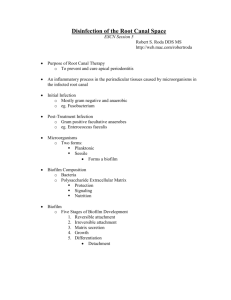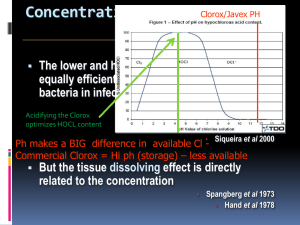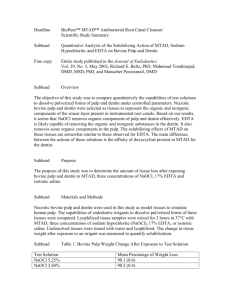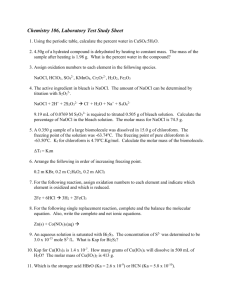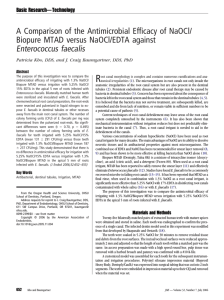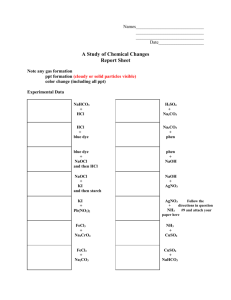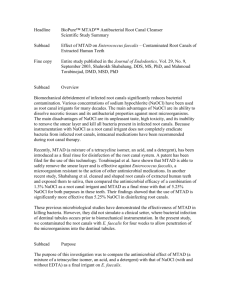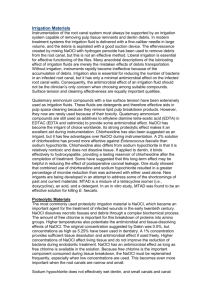Residual antibacterial activity of chlorhexidine and MTAD in human
advertisement
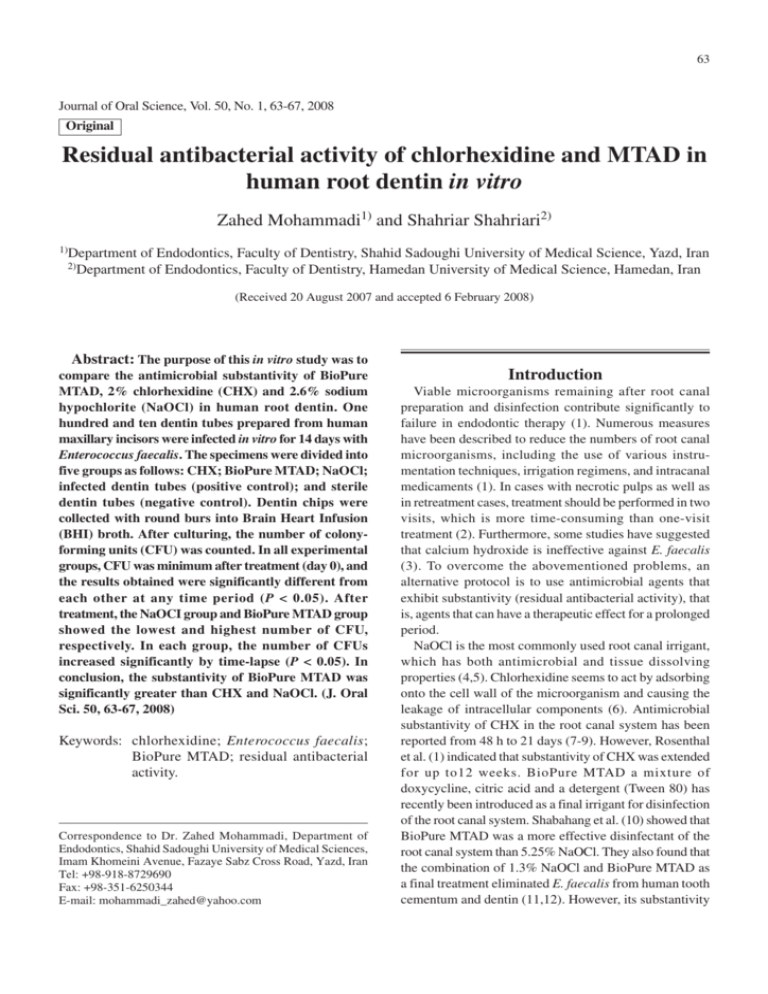
63 Journal of Oral Science, Vol. 50, No. 1, 63-67, 2008 Original Residual antibacterial activity of chlorhexidine and MTAD in human root dentin in vitro Zahed Mohammadi1) and Shahriar Shahriari2) 1)Department of Endodontics, Faculty of Dentistry, Shahid Sadoughi University of Medical Science, Yazd, Iran of Endodontics, Faculty of Dentistry, Hamedan University of Medical Science, Hamedan, Iran 2)Department (Received 20 August 2007 and accepted 6 February 2008) Abstract: The purpose of this in vitro study was to compare the antimicrobial substantivity of BioPure MTAD, 2% chlorhexidine (CHX) and 2.6% sodium hypochlorite (NaOCl) in human root dentin. One hundred and ten dentin tubes prepared from human maxillary incisors were infected in vitro for 14 days with Enterococcus faecalis. The specimens were divided into five groups as follows: CHX; BioPure MTAD; NaOCl; infected dentin tubes (positive control); and sterile dentin tubes (negative control). Dentin chips were collected with round burs into Brain Heart Infusion (BHI) broth. After culturing, the number of colonyforming units (CFU) was counted. In all experimental groups, CFU was minimum after treatment (day 0), and the results obtained were significantly different from each other at any time period (P < 0.05). After treatment, the NaOCI group and BioPure MTAD group showed the lowest and highest number of CFU, respectively. In each group, the number of CFUs increased significantly by time-lapse (P < 0.05). In conclusion, the substantivity of BioPure MTAD was significantly greater than CHX and NaOCl. (J. Oral Sci. 50, 63-67, 2008) Keywords: chlorhexidine; Enterococcus faecalis; BioPure MTAD; residual antibacterial activity. Correspondence to Dr. Zahed Mohammadi, Department of Endodontics, Shahid Sadoughi University of Medical Sciences, Imam Khomeini Avenue, Fazaye Sabz Cross Road, Yazd, Iran Tel: +98-918-8729690 Fax: +98-351-6250344 E-mail: mohammadi_zahed@yahoo.com Introduction Viable microorganisms remaining after root canal preparation and disinfection contribute significantly to failure in endodontic therapy (1). Numerous measures have been described to reduce the numbers of root canal microorganisms, including the use of various instrumentation techniques, irrigation regimens, and intracanal medicaments (1). In cases with necrotic pulps as well as in retreatment cases, treatment should be performed in two visits, which is more time-consuming than one-visit treatment (2). Furthermore, some studies have suggested that calcium hydroxide is ineffective against E. faecalis (3). To overcome the abovementioned problems, an alternative protocol is to use antimicrobial agents that exhibit substantivity (residual antibacterial activity), that is, agents that can have a therapeutic effect for a prolonged period. NaOCl is the most commonly used root canal irrigant, which has both antimicrobial and tissue dissolving properties (4,5). Chlorhexidine seems to act by adsorbing onto the cell wall of the microorganism and causing the leakage of intracellular components (6). Antimicrobial substantivity of CHX in the root canal system has been reported from 48 h to 21 days (7-9). However, Rosenthal et al. (1) indicated that substantivity of CHX was extended for up to12 weeks. BioPure MTAD a mixture of doxycycline, citric acid and a detergent (Tween 80) has recently been introduced as a final irrigant for disinfection of the root canal system. Shabahang et al. (10) showed that BioPure MTAD was a more effective disinfectant of the root canal system than 5.25% NaOCl. They also found that the combination of 1.3% NaOCl and BioPure MTAD as a final treatment eliminated E. faecalis from human tooth cementum and dentin (11,12). However, its substantivity 64 has not been yet evaluated. The purpose of this study was to compare the antibacterial substantivity of BioPure MTAD, 2% CHX, and 2.6% NaOCl against E. faecalis in human root dentin in vitro. Materials and Methods The method used was a modification of the one previously described by Haapasalo and Orstavik (3). Fifty intact human maxillary incisors were selected for this study. The specimens were kept in 0.5% NaOCl solution for no longer than seven days. autoclaved. They were then kept in an incubator at 37°C for 24 hours to check the efficacy of the sterilization. A total of 110 specimens (dentin tubes) were randomly divided into five groups as follows: Group 1 (30 specimens): BioPure MTAD (Dentsply, Tulsa Dental, Tulsa, OK, USA), Group 2 (30 specimens): 2% CHX (Sigma Chemicals Co., St. Louis, MO, USA), Group 3 (30 specimens): 2.6%NaOCl (Sigma Chemicals Co.), Group 4 (10 specimens): positive control (infected dentin tubes), Group 5 (10 specimens): negative control (sterile dentin tubes). Contamination with Enterococcus faecalis Specimen preparation The apical 5 mm and two-thirds of the crown were removed from each tooth with a rotary diamond saw at 1,000 rpm (Isomet Plus precision saw, Buehler, IL, USA) under water-cooling. Cementum was removed by using polish paper (Ecomet 3, variable-speed grinder-polisher, Buehler, IL, USA), which resulted in a centre-holed piece of root dentin with 6 mm outer diameter (Fig. 1). The roots were then cut into 4-mm-thick slices with a diamond saw as above. The canals of the 4-mm blocks were enlarged with an ISO 023 round bur using slow speed. All teeth and dentin slices were preserved in vials containing tap water during the procedures to avoid dehydration. Remove the smear layer The dentin tubes (n = 110) were individually treated with 5.25% NaOCl, and 17% EDTA (with pH 7.2) to remove the smear layer. Specimen sterilization Each specimen was then placed in a glass tube containing 5 ml BHI broth (Oxoid, Basingstoke, UK) and was Isolated 24-hour colonies of pure cultures of E. faecalis (ATCC 29212) were suspended in 5 ml of BHI. The bottles containing each specimen in groups 1, 2, 3 and 4 were opened under laminar flow. Sterile pipettes were used to remove 2 ml of sterile BHI and to replace it with 2 ml of bacterial inoculum. The bottles were closed and kept at 37°C for 14 days, with the replacement of 1 ml of contaminated BHI for 1 ml of freshly prepared BHI every 2 days, to avoid medium saturation. Antibacterial assessment After the contamination period, each specimen was removed from its bottle under aseptic conditions and the canal was irrigated with 5 ml of sterile saline and dried with sterile paper points. The outer surface of the specimens was covered with two layers of nail varnish, in order to prevent contact of the medicament with the external surface. Then, specimens were fixed at the bottom of wells of 24 well cell culture plates with decontaminated sticky wax, which also obliterated the apical surface of the root canal. Finally, the irrigation solutions were inserted into the canal lumen with sterile 3-ml plastic syringes and 27gauge needles until the dentin tubes were totally filled. Ten minutes after placement of irrigants (1), solutions were removed using sterile paper points. The specimens were then incubated at 37°C for a period of 28 days to maintain humidity. Dentin samples Fig. 1 Schematic view of used dentin tubes (adopted from Gomes et al. (6)) Dentin chips were removed from the canals with sequential sterile low speed round burs with increasing diameters of ISO sizes: 025, 027, 029, 031, and 033 at experimental times of 0, 7, 14, 21, and 28 days, respectively. Each bur removed approximately 0.1 mm of dentin around the canal. The powdered dentin samples obtained with each bur were immediately collected in separate test tubes containing 3 ml of freshly prepared BHI. Thereafter, l00 microlitres from each test tube were cultured on blood agar. Growing colonies were counted and recorded as CFU. 65 Statistical analysis Results were analysed using analysis of variance and covariance with repeated measures (ANOVA) to indicate differences between the experimental groups and the positive control. One-way ANOVA (Tukey's method) was used to indicate differences within each layer. A Log10 transformation of each CFU count was performed to normalize the data before statistical evaluation. Results The results were presented as mean Log10 CFU. The specimens of the negative controls revealed no bacterial growth. The average number of CFU in each positive control specimen was 120 at all experimental periods. The number of CFU in all three experimental groups was minimum after treatment (Table 1). The positive control group showed viable bacteria at all experimental times, which indicated the efficiency of the method. In contrast, the negative control group showed no viable bacteria at all experimental times. At Day 0, the NaOCl group demonstrated the most effective antibacterial action. However, at days 7, 14, 21, and 28, BioPure MTAD demonstrated the most effective antibacterial action (P < 0.05). Discussion Enterococci are gram-positive cocci that can occur singly, in pairs, or as short chains. They are facultative anaerobes, possessing the ability to grow in the presence or absence of oxygen (13,14). Enterococcal infections now account for 12% of nosocomical infections in the United States with the majority of those being caused by E. faecalis (15). E. faecalis is also a normal inhabitant of the oral cavity (16). Its prevalence is increased in oral rinse samples from patients receiving endodontic treatment and retreatment when compared to those with no endodontic history (17). E. faecalis is found in 4-40% of primary endodontic infections (14). However, its frequency in persistent periradicular lesions has been shown to be nine times higher. The prevalence of E. faecalis in root-filled teeth with periradicular lesions using culturing and polymerase chain reaction (PCR) methods is 24-70% and 67-77%, respectively (14). E. faecalis possesses several virulence factors. However, it relies more upon its ability to survive and persist as a pathogen in the root canals of teeth (16). Furthermore, it has been shown that E. faecalis has the capacity to endure prolonged periods of starvation until an adequate nutritional supply becomes available (18). Calcium hydroxide, a commonly used intracanal medicament, has been shown to be ineffective at killing E. faecalis on its own, especially when a high pH is not maintained (6). Current techniques of debridement leave many areas of the root canal completely untouched by the instruments (19). Thus, a root canal irrigant is needed to aid in the debridement of the canals. For improvement of their efficacy, the irrigants must be in contact with the dentin walls and debris (20). The intimacy of this contact depends on the wettability of the irrigant on solid dentin, and this property of the liquid is strictly correlated to its surface tension (20). The surface tension is defined as “the force between molecules that produces a tendency for the surface area of a liquid to decrease” (21). This force tends to limit the ability of the liquid to penetrate a capillary tube. The irrigants for endodontic use should have very low surface tension. The wettability of the solution governs the capability of its penetration both into the main and lateral canals, and into the dentinal tubules (22). By improving the wettability, an irrigant antimicrobial solution could increase its protein solvent capability and enable better activity in uninstrumented areas of RCS (22). Due to the fission multiplication pattern of bacteria, CFU are usually expressed on a Log10 scale. Therefore, a Log10 transformation of each CFU count was performed to normalize the data before statistical evaluation. In fact, in the present study, both depth of penetration and residual antibacterial activity of NaOCl, CHX, and BioPure MTAD were evaluated. The 2.6% NaOCl solution had the most effective antibacterial action after treatment, but its antibacterial action dropped rapidly. This indicates that NaOCl has little to no antibacterial substantivity. The probable reason is that NaOCl has an antimicrobial effect as long as free chlorine is available in the solution (23). Furthermore, due to its high surface tension (21), NaOCl cannot penetrate into deeper layers of dentin. The mean numbers of CFU were statistically lower in BioPure MTAD Table1 Means of the Log10 CFU and the Standard Deviation of E. faecalis in experimental groups 66 compared to other solutions at all experimental periods except for the first time, thus stressing the ability of BioPure MTAD to adsorb to hydroxyapatite with prolonged and gradual release at therapeutic levels. In addition, presence of a detergent (Tween 80) in BioPure MTAD reduces its surface tension and thus improves its penetration into deep layers of dentin. Shabahang and Torabinejad (12) compared the antibacterial effect of BioPure MTAD with that of NaOCl with and without EDTA. Their findings showed that the combination of 1.3% NaOCl as a root canal irrigant and BioPure MTAD as a final rinse was significantly more effective than the other regimens. They attributed the effectiveness of BioPure MTAD to its anticollagenase activity, low pH, and ability to be released gradually over time. Kho and Baumgartner (24) compared the antimicrobial efficacy of irrigating with 1.3% NaOCl/ BioPure MTAD versus irrigation with 5.25% NaOCl/15% EDTA in the apical 5 mm of roots infected with E. faecalis. Their results demonstrated that there was no difference in antimicrobial efficacy for irrigation with 5.25% NaOCl/15% EDTA versus irrigation with 1.3% NaOCl/BioPure MTAD. In another study, Krause et al. (25) compared the antibacterial effect of BioPure MTAD, NaOCl, doxycycline, and citric acid on E. faecalis. Their findings showed that NaOCl was more effective than other solutions. Khademi et al. (26) compared the antibacterial substantivity of 2% CHX, 100 mg/ml doxycycline, and 2.6% NaOCl in bovine root dentin in vitro. They found that substantivity of CHX was significantly greater than doxycycline, and NaOCl, which is in contrast to the findings of the present study. It seems that the presence of a detergent (Tween 80) in BioPure MTAD increases the depth of penetration of this material into dentinal tubules by decreasing surface tension. There is a considerable debate in the literature regarding the time of dentin treatment to induce substantivity. Some studies have shown that dentin should be treated for one week. On the other hand, some works studies have demonstrated that only 5-10 min. treatment with CHX induces substantivity for even 12 weeks. Rosenthal et al. (1) found that treatment with a 2% solution of CHX induced substantivity for up to 12 weeks, which is in contrast to the findings of the present study. However, White et al. (7) concluded that antimicrobial activity of 2% CHX as a canal irrigant lasted 72 hours. In an in vivo study to evaluate the substantivity of 2% CHX as root canal irrigating solution, Leonardo et al. (8) found that CHX prevents microbial activity with residual effects in the root canal system up to 48h, whereas the present study showed that substantivity of 2% CHX remained for 28 days. Komorowski et al. (27) reported that for induction of substantivity, dentin should be treated with CHX for 7 days and 5 min. treatment with CHX did not induce substantivity, which is in contrast to our findings. Lin et al. (28) attributed the limited antibacterial effect of CHX irrigation to absorb the medication to dentin during the first hour and stated that only after the saturation point after the first hour that the antibacterial capability of CHX increases with time. Stabholz et al. (29) found that the antimicrobial substantivity of CHX was significantly lesser than tetracycline HC1 50 mg/ml for 12 days. It should be noted that the extrapolation of the results of such in vitro studies to clinical situations should be done with caution. There are several reasons for the poorer in vivo performance of the irrigants and medicaments as compared with in vitro results. It has been shown that dentin, its components, and contents of the root canal system (30) affect the performance of irrigants. Under the conditions of the present study, the substantivity of BioPure MTAD was significantly higher than CHX and retained in root canal dentin for at least 28 days. Furthermore, NaOCl displayed no substantivity. References 1. Rosenthal S, Spangberg L, Safavi K (2004) Chlorhexidine substantivity in root canal dentin. Oral Surg Oral Med Oral Pathol Oral Radiol Endod 98, 488-492 2. Trope M, Bergenholtz G (2002) Microbiological basis for endodontic treatment: can a maximal outcome be achieved in one visit? Endodontic Topics 1, 40-53 3. Haapasalo M, Orstavik D (1987) In vitro infection and disinfection of dentinal tubules. J Dent Res 66, 1375-1379 4. Bystrom A, Sundqvist G (1983) Bacteriologic evaluation of the effect of 0.5 percent sodium hypochlorite in endodontic therapy. Oral Surg Oral Med Oral Pathol 55, 307-312 5. Hasselgren G, Olsson B, Cvek M (1998) Effect of calcium hydroxide and sodium hypochlorite on dissolution of necrotic porcine muscle tissue. J Endod 14, 125-127 6. Gomes BP, Souza SFC, Ferraz CCR, Teixeira FB, Zaia AA, Valdrighi L, Souza-Filho FJ (2003) Effectiveness of 2% chlorhexidine gel and calcium hydroxide against Enterococcus faecalis in bovine root dentin in vitro. Int Endod J 36, 267-275 7. White RR, Hays GL, Janer LR (1997) Residual antimicrobial activity after canal irrigation with chlorhexidine. J Endod 23, 229-231 8. Leonardo MR, Tanomaru Filho M, Silva LAB, Nelson Filho P, Bonifacio KC, Ito IY (1999) In vivo antimicrobial activity of 2% chlorhexidine 67 used as a root canal irrigating solution. J Endod 25,167-171 9. Basrani B, Santos JM, Tjaderhane L, Grad H, Gorduysus O, Huang J, Lawrence HP, Friedman S (2002) Substantive antimicrobial activity in chlorhexidine treated human root dentin. Oral Surg Oral Med Oral Pathol Oral Radiol Endod 94, 240242 10. Torabinejad M, Khademi AA, Babagoli J, Cho Y, Johnson WB, Bozhilov K, Kim J, Shabahang S (2003) A new solution for the removal of the smear layer. J Endod 29, 170-175 11. Torabinejad M, Shabahang S, Aprecio RM, Kettering JD (2003) The antimicrobial effect of MTAD: an in vitro investigation. J Endod 29, 400-403 12. Shabahang S, Torabinejad M (2003) Effect of MTAD on Enterococcus faecalis- contaminated root canals of extracted human teeth. J Endod 29, 576-579 13. Gilmore MS (2002) The Enterococci: pathogenesis, molecular biology, and antibiotic resistence. ASM Press, Washington, 1-2 14. Rôças IN, Siqueira JF Jr, Santos KRN (2004) Association of Enterococcus faecalis with different forms of periradicular diseases. J Endod 30, 315320 15. Franz CM, Stiles ME, Schleifer KH, Holzapfel WH (2003) Enterococci in foods: a conundrum for food safety. Int J Food Microbiol 88, 105-122 16. Stuart CH, Schwartz SA, Beeson TJ, Owatz CB (2006) Enterococcus faecalis: its role in root canal treatment failure and current concepts in retreatment. J Endod 32, 93-98 17. Sedgley CM, Lennan SL, Clewell DB (2004) Prevalence, phenotype, and genotype of oral Enterococci. Oral Microbiol Immunol 19, 95-101 18. Figdor D, Davies JK, Sundqvist G (2003) Starvation survival, growth and recovery of Enterococcus faecalis in human serum. Oral Microbiol Immunol 18, 234-239 19. Shabahang S, Pouresmail M, Torabinejad M (2003) in vitro antibacterial efficacy of MTAD and sodium hypochlorite. J Endod 29, 450-452 20. Pécora JD, Guirnarães LF, Savioli RN (1991) Surface tension of several drugs used in endodontics. Braz Dent J 2, 123-127 21. Taşman F, Cehreli ZC, Oğan C, Etikan I (2000) Surface tension of root canal irrigants. J Endod 26, 586-587 22. Cameron JA (1986) The effect of a fluorocarbon surfactant on the surface tension of the endodontic irrigant sodium hypochlorite. A preliminary report. Aust Dent J 31, 364-368 23. Zehnder M (2006) Root canal irrigants. J Endod 32, 389-398 24. Kho P, Baumgartner JC (2006) A comparison of the antimicrobial efficacy of NaOCl/Biopure MTAD versus NaOCl/EDTA against Enterococcus faecalis. J Endod 32, 652-655 25. Krause TA, Liewehr FR, Hahn CL (2007) The antimicrobial effect of MTAD, sodium hypochlorite, doxycycline, and citric acid on Enterococcus faecalis. J Endod 33, 28-30 26. Khademi AA, Mohammadi Z, Havaee A (2006) Evaluation of the antibacterial substantivity of several intra-canal agents. Aust Endod J 32, 112115 27. Komorowski R, Grad H, Wu XY, Friedman S (2000) Antimicrobial substantivity of chlorhexide-treated bovine root dentin. J Endod 26, 315-317 28. Lin S, Zuckerman O, Weiss EI, Mazor Y, Fuss Z (2003) Antibacterial efficacy of a new chlorhexidine slow release device to disinfect dentinal tubules. J Endod 29, 416-418 29. Stabholz A, Kettering JD, Aprecio R, Zimmerman G, Baker PJ, Wikesjo UM (1993) Retention of antimicrobial activity by human root surfaces after in situ subgingival irrigation with tetracycline HCL or chlorhexidine. J Periodontol 64, 137-141 30. Haapasalo M, Qian W, Portenier I, Waltimo T (2007) Effects of dentin on the antimicrobial properties of endodontic medicaments. J Endod 33, 917-925
